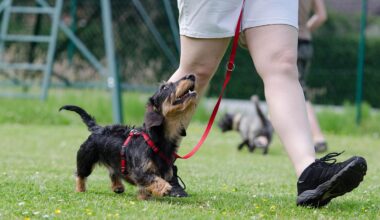Understanding Play Signals: How Dogs Communicate During Play
Dogs are inherently social creatures. Their ability to communicate effectively through play is critical for their development and mental health. Play serves numerous purposes for dogs; it strengthens social bonds and provides necessary exercise. Watching dogs play reveals a complex language of body signals and vocalizations. By learning these signals, owners can improve interactions with their pets. Understanding how dogs signal playful intentions enhances mutual respect and reduces conflicts. Throughout play, dogs utilize body language, facial expressions, and sounds to convey their feelings. For example, a dog may lower its front body while keeping its rear end elevated, indicating a “play bow.” This stance invites the playmate to engage. When you recognize these signals, it’s easier to facilitate positive experiences. Additionally, play helps dogs manage aggression and anxiety, promoting a balanced temperament. By fostering an environment where play is encouraged, owners support their dog’s psychological needs. Engaging in regular play also strengthens relationships, as both dog and owner learn to read each other more effectively. Playtime serves as an essential tool for training and socialization, shaping a dog’s behavior positively.
The Importance of Play in Dog Psychology
Understanding why play is crucial encompasses numerous aspects of dog psychology. Dogs engage in play for various reasons, including learning social skills and reinforcing bonds with their pack. Notably, puppies learn about their surroundings and how to interact with others through play. This interaction encompasses different forms of canine communication. Social play helps to establish hierarchy within a group, which is vital for harmonious existence. Play can also teach boundaries, leading to better behavior in adult dogs. A well-socialized dog is less likely to display aggressive behavior or anxiety in different environments. Their initial play experiences shape their confidence and adaptability. Moreover, many behavioral problems stem from insufficient playtime and mental stimulation. Boredom can lead to destructive behaviors as dogs seek alternative outlets for their energy. Therefore, encouraging various play types, such as fetch, tug-of-war, or agility courses, meets their physical and emotional needs. Including structured play in daily routines helps maintain good mental health in dogs. Observing and participating in your dog’s playtime fosters deeper connections, providing a joyful, enriching experience that benefits both dog and owner.
Recognizing play signals enhances the relationship between the dog and its owners. Understanding these signals helps owners interpret their dog’s feelings accurately. For example, if a dog shows a relaxed posture and wagging tail, it is signaling happiness and excitement. If it suddenly halts and stares or lowers its ears, it might need a break or feel uncomfortable. Observing play helps one learn when to engage or step back. Effective communication during play strengthens trust and allows for more enjoyable experiences. Often, dogs fluff their fur as an expression of excitement, an invitation to join the play. It’s important to avoid interrupting their fun unless necessary, as this can lead to frustration or anxiety. Engaging in their play signals signals an understanding of their needs. Furthermore, different breeds exhibit various play styles, and recognizing these differences can help owners plan appropriate playtime activities. In turn, these activities bolster the emotional well-being of the dog. Owners should routinely dedicate time to observe and participate in play to forge stronger relationships based on trust and respect.
Different types of play exhibit specific signals that dogs use to communicate. For instance, chasing games provoke a range of responses. During these play sessions, dogs may use vocalizations like barks or growls, conveying excitement. Tracking their motions also helps determine their preferred games. Roughhousing, for example, encourages a different set of signals compared to fetch. During rough play, dogs may show signs like snapping and play-bowing. Often, the higher energy levels require careful observation to ensure everyone remains safe. A dog’s willingness to pause and check in with its playmate signifies its need for balanced engagement. Play should not escalate into aggression; understanding when this happens allows for timely interventions. A well-timed distraction or redirecting attention keeps the play fun and safe. Moreover, older dogs may demonstrate gentler approaches, teaching enthusiastic puppies about self-control. During these interactions, noticing variations in both dogs’ play styles enriches the experience. Owners should tailor play activities, accommodating different temperaments and energy levels. Gradually increasing complexity of games cultivates learning opportunities infused with playfulness.
When observing dogs, it is essential to recognize their body language in relation to play signals. The postures dogs adopt reveal how engaged or comfortable they are during play. For example, a dog might exhibit a high-energy stance with its ears perked and tail wagging enthusiastically when excited. Conversely, lowered tails or tucked ears indicate apprehension or the need for a calm moment. Careful observation ensures interactions remain safe and enjoyable. Dogs may also display facial expressions, such as relaxed mouths or bright eyes, conveying friendliness. Vocalizations complement these signals; playful barks and yips signify willingness, while growls may indicate overexcitement or a need to pause. Being in tune with both verbal and physical cues can enhance the owner-dog bond immensely. Moreover, dogs have individual preferences for play styles, and understanding these nuances helps customize games that best suit them. Every dog’s personality contributes to their unique way of playing with others. Engaging with your dog through observation fosters an environment where everyone thrives emotionally and physically. Ultimately, noticing and responding to signals reinforces connection and understanding.
The role of environment in play cannot be overstated. Safe, enclosed spaces allow dogs to explore their surroundings and engage in enriching activities. Various types of surfaces, such as grass, gravel, and sand, provide different sensory experiences, promoting exploration. Ideally, engaging in play outdoors exposes dogs to scents and sounds that stimulate their natural instincts. Off-leash play in controlled areas encourages socialization with other dogs, reinforcing communication skills. However, monitoring dog interactions closely remains crucial; not all dogs read signals correctly, leading to miscommunications. Alternatively, indoor games, such as puzzle toys or hide-and-seek, stimulate cognitive play and can be rewarding during inclement weather. Furthermore, incorporating agility equipment or teaching tricks can provide both physical and mental stimulation. The environment plays a pivotal role in facilitating development. Creating varied play environments ensures dogs remain mentally engaged and promotes healthy activity levels. Owners should remain adaptable, altering play settings regularly to maintain dogs’ interest. Ultimately, creating a dynamic and enjoyable play environment cultivates lifelong skills and a happier temperament.
In conclusion, recognizing the significance of play in dog psychology is essential for developing well-rounded pets. By understanding play signals and behaviors, owners can enhance their interactions with their dogs, ultimately fostering deeper connections. Play serves numerous purposes: from socializing to providing mental stimulation. By facilitating safe and enriching play experiences, owners can combat behavioral issues while promoting a dog’s emotional health. Observing how dogs communicate during playtime highlights the importance of individual preferences, ensuring tailored activities to maximize enjoyment. Additionally, maintaining a safe and stimulating environment supports positive play experiences. Dogs thrive on consistent interactions, clear boundaries, and ample playtime. Education on play signals allows owners to interpret their dogs’ intentions accurately. Engaging in joyful playtime nurtures relationships built on mutual understanding, trust, and respect. Through shared experiences, owners and dogs develop emotional bonds that transcend basic companionship. Ultimately, understanding canine play informs better pet ownership practices, promoting a harmonious, enriching life for both dogs and their human companions. Embracing play as a central aspect of dog care leads to happier, healthier pets that thrive socially and emotionally.


